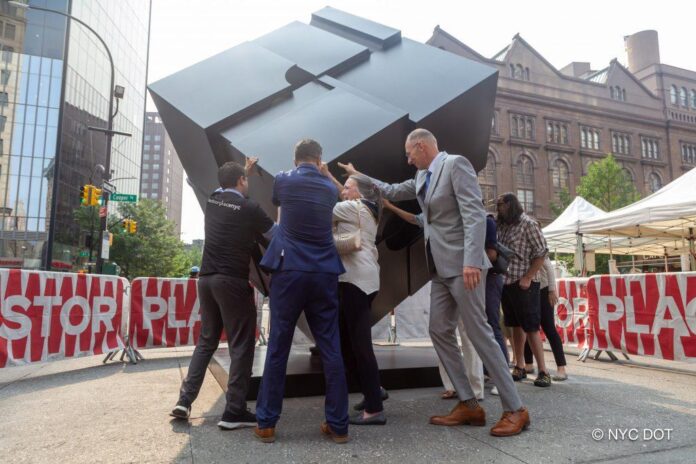The famed Astor Place Cube, officially titled was reinstalled in Manhattan’s East Village today following two months of repairs.
The eight-foot-tall Cor-Ten steel sculpture by Bernard “Tony” Rosenthal, which weighs 1,800 pounds, has been a fixture of Astor Place since 1967. But in May, it left its normal East Village perch to allow the late artist’s estate to carry out much-needed repairs.
“The cube is a true icon… not only of the East Village and Astor Place, but of New York City and the United States. Millions of visitors want to come here to spin or take a photo of this great sculpture,” said Ydanis Rodriguez, commissioner of the New York City Department of Transportation, which oversees the sculpture, at today’s unveiling ceremony.
The sculpture is popular for its interactivity, with a mechanism that allows it to spin when pushed by several people but for the last year that mechanism had stopped working. The cube was restored to its spinning glory over the last few months by Versteeg Art Fabricators. pic.twitter.com/HH6MhsoHMK
— NYC DOT (@NYC_DOT) July 18, 2023
Before its reinstallation today, the sculpture took an unexpected sojourn out east, where it appeared at the Hamptons Fine Art Fair this past weekend. The visit, first reported by Dan’s Papers, was organized in celebration of Rosenthal’s posthumous induction into the Hamptons Artists Hall of Fame.
“It’s one of the great landmarks of New York. A lot of people were taking selfies,” Rick Friedman, the fair’s executive director, told Artnet News.
At the fair, was part of a 17-work outdoor sculpture park erected for the occasion. The Tony Rosenthal estate sold a seven-and-a-half-foot replica of the cube sculpture at the fair for $250,000. The buyer, the Pauline and Austin Neuhoff Foundation in Dallas, snapped up the work within 10 minutes of the opening of the fair’s vernissage on Thursday.
A record 12,000 guests visited this year’s fair, which closed three hours early on Sunday due to flooding from torrential rain. The DOT oversaw ’s removal by crane on Monday morning, transporting it back to Manhattan via truck, the reported.

Bernard “Tony” Rosenthal, (1967). The artwork known as the Astor Place Cube being removed for restoration. Photo courtesy of the New York City Department of Transportation.
Originally intended as a six-month installation as part of New York City’s first major public art show in 1967, was an immediate hit and became a permanent part of the downtown landscape. A large part of its appeal was actually a happy accident: Rosenthal had intended the work be locked into place, but the public soon realized you could push the cube to turn it on its axis.
Spinning the cube has become something of a rite of passage among New Yorkers, especially for nearby New York University students. But the rotating mechanism broke in 2021, and the sculpture was beginning to tip over. The city installed a metal brace as a temporary measure to hold it in place, and then sent to a foundry for a $100,000 restoration that included mechanical repairs and painting.
Now that has been restored to its fully spinning glory, the Village Alliance has pledged to manage the day-to-day maintenance of the sculpture and the surrounding plaza, ensuring its continued presence in Astor Place.

Bernard “Tony” Rosenthal’s , better known as the Astor Place Cube on loan to the Hamptons Fine Art Fair in Southampton. Photo by Patrick McMullan/PMC.
“I get asked very often what makes a great work of public art,” Kendal Henry, the assistant commissioner of public art at the New York City Department of Cultural Affairs, said at the unveiling. “You know when a work of art was supposed to be up for six months, but [after] over 50 years its still here; you know when a piece is damaged not from vandalism, but from love of use; you know when it becomes an urban legend—is there a man living in the cube?—and you know when other artists are using the image in their own artwork.… This, I dare say, is one of the most successful works of art in New York City.”

























